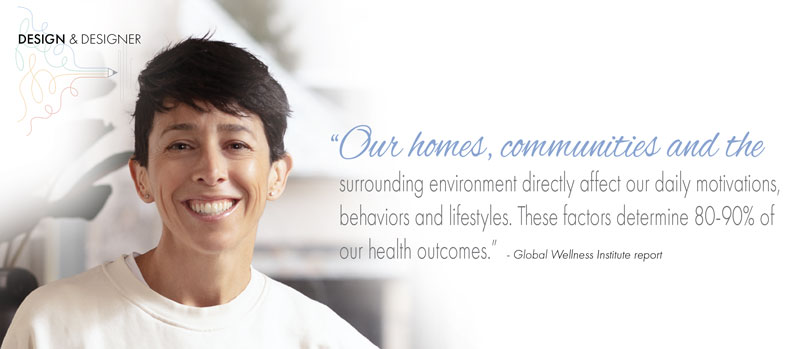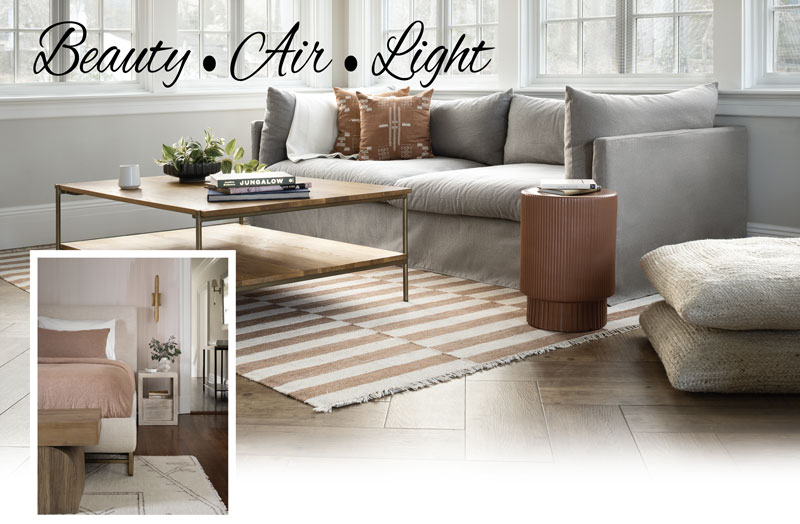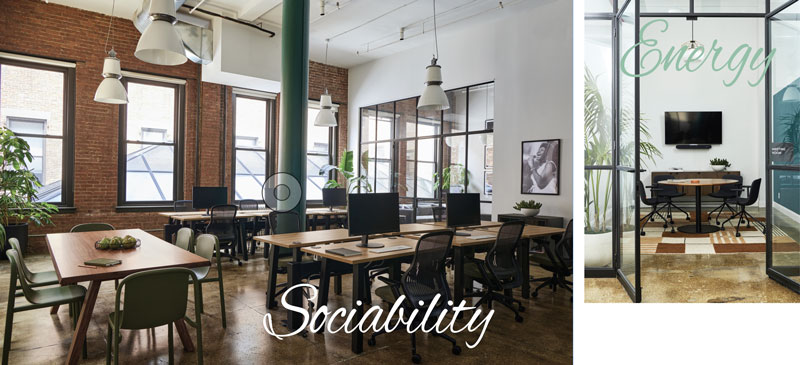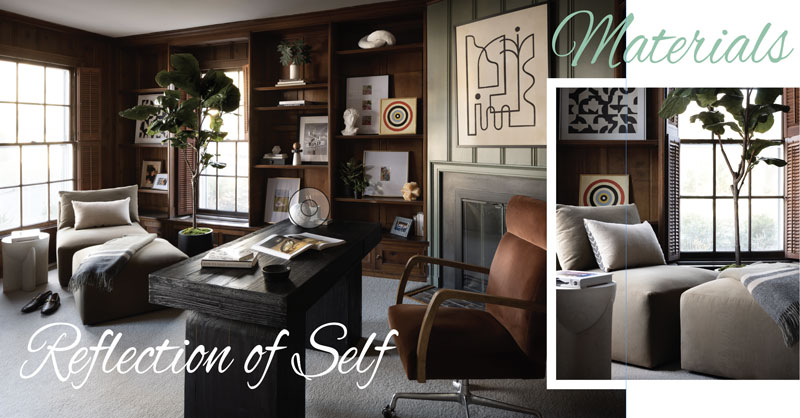INTERVIEW WITH GALA MAGRIÑÁ
Positive change starts with being mindful that every shape, color and material used in interior spaces affects people’s health, social interactions and well-being.
If you listen to the morning news, read consumer magazines or peruse the New York Times list of best-selling books, you know that consumer interest in health & wellness is at an all-time high. Product tie-ins have exploded as businesses go out of their way to address customer interest in improving health, well-being and longevity as a product and brand differentiator. But what about the home furnishings business? Aside from a recent focus on selling the science of sleep, many Furniture World readers find it far-fetched to add home/healthy life messaging to their industry’s steady diet of product/price and pretty-home messaging. But this idea is not new. The idea of redesigning home interiors to improve health and well-being is over 5,000 years old.
The July-August edition of Furniture World featured an interview with Mike Peterson and Linda Kafka, founders of Science in Design. They explained how forward-thinking designers, corporations and some furniture retailers have incorporated neuroaesthetic concepts into designed spaces (including retail showrooms). The result is improvements in biometric measures that are highly correlated with positive health outcomes.
Gala Magriñá Design
This installment in Furniture World’s Design & Designer series expands that health and wellness discussion with ideas from Gala Magriñá, designer and principal of New York City-based Gala Magriñá Design.
Raised in New York City and Barcelona, Magriñá is an interior designer and brand strategist. Her career has been shaped by her experience as an NYU film student, her role at Diesel, the well-known denim lifestyle brand, and as the founder of M Crown Productions, an award-winning production design agency focused on event design, pop-ups, exhibitions and retail displays. Building on her early successes, she launched Gala Magriñá Design in 2017.
“I am guided by our clients’ needs, goals and the stories we decide to tell,“ she said. “When designing a space, I become a creative conduit for ideas and strategies to bring clients’ homes and businesses to life. Mix in the incredible insight of my team, our obsessive attention to detail and a desire to leave the world in a better place than we found it—and standout, mindful interiors delivered on time and budget are the result. Our focus is on creating mindful environments that have the power to heal and help people become better versions of themselves. It’s a way to elevate individual consciousness and, in turn, the collective consciousness.”
The tools she combines with her retail, visual merchandising and event planning experience make Magriñá’s process different from many of her industry peers. These include the application of holistic design principles, Feng Shui, knowledge of healthy materials, Vaastu and mindful practices.
“My main job at Diesel,” she recalled,” was visual merchandising. That’s where I learned to focus on the details of creating fashion windows and displays. Small, temporary displays have to be meticulously crafted. Moving up the corporate ladder, my responsibilities shifted to event design and production. It’s a whole other logistics beast that requires moving very quickly. When 500 people show up for an event, no matter what happens in the design and planning stages, it must be ready to go.

Brand strategist and interior designer Gala Magriñá uses tools such as Feng Shui, Holistic Interior Design and Vaastu, an ancient Indian system of architecture.
“These career experiences have helped our design agency to be buttoned up with our processes and procedures. And our holistic approach allows us to go beyond what we can see, hear, touch, and smell. Interior design is way more than just the physical world.”
All Things Wellness
She set out on a holistic design path in 2018 after reading a report from the Global Wellness Institute. “The non- profit is a wonderful resource for all things wellness,” she added. “Their report alerted me to the fact that ‘Our homes, communities and the surrounding environment directly affect our daily motivations, behaviors and lifestyles. These factors determine 80-90% of our health outcomes.’”
Whereas most interior designers focus on creating beautiful, functional rooms using widely accepted interior design principles and elements, Magriñá said she’s always been interested in the energy of spaces. “That curiosity,” she observed, “took me on a path that includes studying tools such as Feng Shui, Holistic Interior Design and Vaastu, an ancient Indian system of architecture.
“These disciplines provide a language to evaluate physical spaces and read environments. Traditional interior design is all about beauty and function. Holistic design goes deeper by acknowledging the tremendous effect of spaces on the lives of people who live, work and shop in them. Like designers who use traditional tools, our firm creates beautiful and functional spaces. In addition, we bring to our practice a strong focus on nurturing people, supporting their health, well-being, relationships, and human potential.”
Working with Clients
Magriñá shared how she works with clients and ideas regarding how retailers might incorporate holistic design into their business models to change how people think about the benefits of furnishing their homes.
“The spaces our clients live in reflect their identities,” she observed. “When people open up and feel comfortable enough to have a deep conversation about their homes, the creation of exceptional designs and personal transformation is more likely to happen. Nothing is more rewarding than designing intentional, conscious spaces for clients who understand that I’m helping them lead better lives.”
Translation to Retail
Furniture World asked her if focusing on transforming lives might translate from an interior design perspective to retail sales. Shoppers may enter a furniture store to replace uncomfortable mattresses or refresh their living rooms. They are not expecting life-changing designs.
“It can for some retailers,” she replied. “That depends on what a shopper or client wants. Some clients will tell me, ‘I read about holistic interior design, and you’re at the forefront. I want to work with you in this way.’ Others say that they like our design work. We don’t push our agenda on them. It’s important to meet people where they’re at.”
For Magriñá, that means asking more questions. A similar but less detailed qualification approach could work for furniture retailers.
“Through our intake form,” she continued, “I get a sense of what they want us to do for them. Is it just interior design that makes their spaces look cool? OK, we can do that. Or do they want to go a little bit deeper?
“At retail, salespeople might start a holistic design conversation by asking how shoppers want to feel in their spaces. Bright colors energize. Lighter, softer colors bring moods down and help to ground people. Ask about furniture placement. Do they plan to do a lot of entertaining, or are they looking for help to create a more relaxing, sanctuary feel?
“At retail, salespeople might start a holistic design conversation by asking how shoppers want to feel in their spaces. Bright colors energize. Lighter, softer colors bring moods down.”
“Do they have trouble getting up in the morning or feel too energetic to fall asleep at night? If so, maybe steer the conversation to their bedrooms. If they have problems winding down, suggest rounder shapes, softer textures, more muted tones and pictures of nature. We let our clients know we plan to do X, Y, and Z so they end up with environments that support their well-being. We often hit the nail on the head, giving them something they didn’t realize they needed. That’s a real win.
“If a store sells organic or certified toxin-free furniture and bedding, find out if the shopper has a reason to be interested in healthy materials to address that concern.
“I find out if clients have sleep issues, anxiety, a high-stress job or feel blocked anywhere. Then I let them know I’m asking these questions to address these issues through the design to better support them and help transform their lives.”
Getting Into Spaces & Heads
Making house calls has always been the gold standard for design-oriented retailers, a way to push closing rates well beyond 80% and uncover other customer needs that result in add-on sales. Magriñá observed, “The spaces my clients live in reflect who they are, want to be or what they want other people to think of them. Their rooms also reflect what they may or may not know about themselves.”

Gala Magriñá Design created the family room to be durable, comfortable and inviting, incorporating natural materials such as wood, cotton, ceramics and sisal. Plants brought nature into the space which studies have shown to have myriad positive effects. Based on the client’s lifestyle, creating a calming, sanctuary-like primary bedroom was warranted. Chosen were light woods, soothing textures, and whimsical wallpaper to create a space where clients can go for deep rest and relaxation.
This presents an opportunity for her to “read” the space and identify how her clients might improve those spaces in ways that enhance their lives.
“When we care for ourselves and our spaces, shifts happen. There are many examples,” she said. “A cluttered home suggests that a person is not only holding on to physical but also emotional baggage. Clearing it makes room for new opportunities to enter our lives. Dead space equals dead energy.”
Holistic Interior Design
Magriñá explained that there are 12 categories of holistic interior design. Links to scientific studies and abstracts with more information on the following categories can be accessed by scanning the QR code below.
The following explanations of holistic interior design are excerpts from www.galamagrinadesign.com.
-
Beauty + Neuroaesthetics
Aesthetics matter. It’s important to create spaces that are a feast for the eyes.
-
Air
HVAC and purifying systems ensure good air quality, which affects respiratory health.
-
Light
Proper lighting that mimics natural sunlight as closely as possible promotes health and mood.
-
Feng Shui and the language of space
The practice of Feng Shui addresses how the spaces people inhabit relate to their lives, their families, society and the environment. Feng Shui practitioners often adjust rooms to eliminate household items that have painful negative associations or add elements that have positive ones. Architectural features, furniture and other items can be added to improve the energy and enjoyment of a space, encourage conversation, facilitate desired family dynamics or encourage the realization of specific goals.
-
Energy
Clear negative energy from a space and set intentions for things like good luck, abundance and prosperity.
-
EMFs+Geopathic Abnormalities
Electromagnetic disturbances can negatively affect the nervous system.

Many work environments do not include spaces that encourage socializing and interaction. Loneliness has become one of the biggest impediments to employee wellbeing. This was a major consideration for Gala Magriñá’s design for the office spaces pictured above.
-
Color
Colors have a direct impact on our feelings. They should fit the use of the space and support individual goals.
-
Biophilia
Bringing nature into interior spaces has been shown to boost mood, concentration, and productivity while lowering stress, heart rate, and blood pressure. See “Biophilia, The Next Big Thing” at www.furninfo.com/furniture-world-articles/4063.
-
Sociability
Healthy relationships are essential to well-being. Designing spaces with this in mind helps mediate the social interactions of those who use them.
-
Materials
Materials that contain toxic elements or pollute indoor air should be avoided.
-
Sustainability
Being holistic means thinking about the larger impact of our designs. Prioritize sustainable materials and eco-conscious vendors.
-
Spaces as a reflection of self
Just as energy equals matter (E=mc²), the spaces people create reflect their true selves consciously or subconsciously.

The project above infused a 6,100 square-foot colonial-style home built in 1929 with pops of complementary color and style. Previously dark, stuffy and old-looking, the renovation included a new carpet, a light green painted wall panel, plants, art and props to make it more modern and inspiring. When designing utilitarian commercial and home office environments, inspiration, mood enhancement and well-being are factors that are not always considered.
Changing Lives With Aesthetics
“In terms of the aesthetic elements you might see repeated in our work,” she said, “are plants, natural materials and bright abstract art. Our style is an eclectic pop modernism—very clean but not cold.
“Just as diet and exercise promote health, being intentional about our spaces and ensuring they reflect who we are is important to our well-being.”
“Even though the types of spaces we design are varied, a red line runs through all our work. Maximalist approaches can be too much for most people to live with day in and day out.
“I’m not saying that changing a home environment can, by itself, change people’s lives. It’s another tool. Just as diet and exercise promote health, being intentional about our spaces and ensuring they reflect who we are is important to our well-being. Humans are built to adapt and evolve as a survival mechanism. But when it comes to the spaces they live and work in, many people have accepted that it’s OK to spend most of their lives in subpar interior environments. That’s true for people who work in spaces with poor lighting and clutter. My experience is that when asked if they are OK with living that way, people say, ‘Yeah, I’m fine.’ But if I dig deeper, they take a second to look around, as if for the first time and admit, no they are not actually happy with their environment.”
Hundreds, perhaps thousands of furniture retailers’ mission statements and marketing material include language about helping customers create the homes of their customer’s dreams, beautiful/gorgeous homes, unbeatable quality, style, comfort, service, and promises to help them find their unique styles. How much more powerful would it be to emphasize the value of design to promote happier, healthier lives? If the bottom half of a window is stuck, most folks will continue to try to pull it up with all their might, never realizing that pushing it down first may solve the problem. That’s because they haven’t considered that there’s a better way. “The fact is,” said Magriñá. “People continue to live with furnishings that they don’t like. Add up all the subpar elements and it becomes apparent that many homes are energy drains versus nurturing and supportive environments.”

Gala Magriñá Design did a full remodel of this apartment choosing soft tones, natural woods, and a variety of textures to create some major “sanctuary” vibes throughout, letting New York City be the star of the show. Incorporated was a biomorphic wallpaper pattern and curved headboard, other ways to bring nature into the space.
Ideas for Retailers
When asked to share her thoughts about the retail furniture store experience, Magriñá observed, “Some retailers pile on lots of in-store technology, but in my mind, shoppers’ needs are simple. They want to see great visual merchandising that conveys how they want to feel in their homes. It’s an opportunity to create a vibe versus just trying to sell a credenza. They want to see solid product assortments and meet with salespeople who are easy to talk to, friendly and ‘get them.’ Retailers often miss the mark if they don’t play music that’s upbeat, fun and puts people in a mood to buy. And in many furniture stores, lighting is a huge mess, with hot spots, poor areas of illumination and poor color temperature.
“It’s all about the vibe a furniture store wants to create. How do they want people to feel when they come in? Probably, comfortable and inspired.”
Employee Areas
For most retailers, consumer-facing sales areas come first, but paying attention to how employees feel in their working environments should be equally important.
“My experience from working at retail is that employee lounges and offices are typically in the least desirable areas—like the basements.,” Magriñá observed. “Add a folding table and two chairs, and it’s like they are sitting in a stockroom. So many of these spaces are cluttered, have poor lighting and insufficient ventilation. Retailers’ most important selling assets are professional salespeople, exceptional visual merchandising, and solid product assortments. It’s natural for merchants to want to max out the front of the house and minimize the back. Applying holistic design principles to employee areas can help shift their daily motivations, behaviors and productivity in a positive direction. Improving those areas shouldn’t be an afterthought.”
Opportunities
Moving on to discuss the most significant opportunities for designers, retailers, and brands going forward, Magriñá said, “I might not have thought this before I witnessed the smoke coming from Canadian wildfires turning the New York City sky an apocalyptic orange, but there has to be a future for home furnishings companies that focus on sustainability and health. It’s time to take the first steps, even small ones, to educate customers and focus on making the products they buy and sell more sustainable, less toxic and healthy. Right now, our customers need to see small ripples that lead to bigger ripples.”
In closing, she advised that “understanding the impact designed environments have on people’s lives and feeling a sense of responsibility to help them create healthy spaces is needed. Positive change starts with being mindful that every shape, color and material we choose and place for them can affect their social interactions, health and well-being.
“I’ll leave Furniture World readers with one final comment. It’s a little ‘out there,’ but it illustrates the gravitas I feel for what interior designers, architects, contractors and retailers can do. From the perspective of the infinite, there’s a source-energy, a Big Bang consciousness or whatever you might call it, that created the universe. A reflection of that creative power resides in the energy of the people who design, build and furnish living and working spaces. In other words, we have a real opportunity to create worlds that nurture and sustain. And so, as an industry, there is a huge responsibility.”